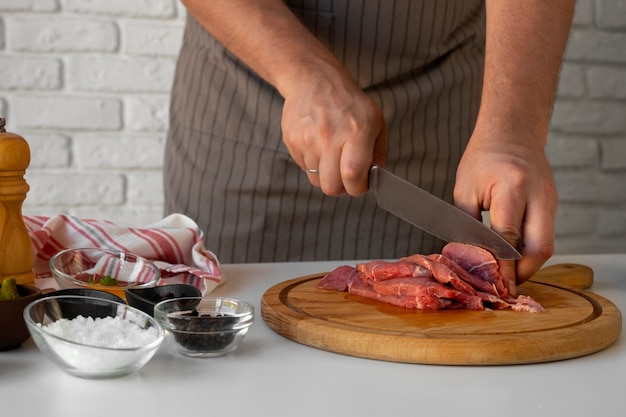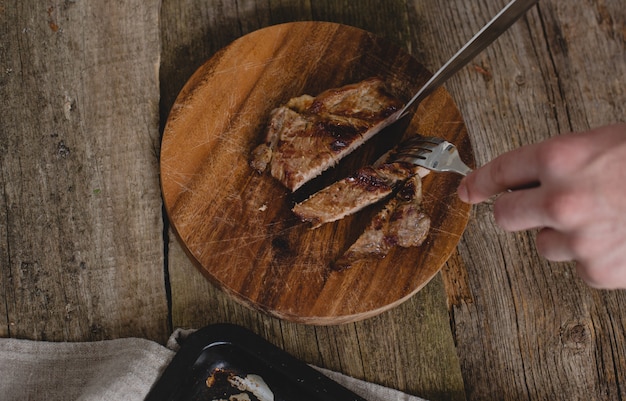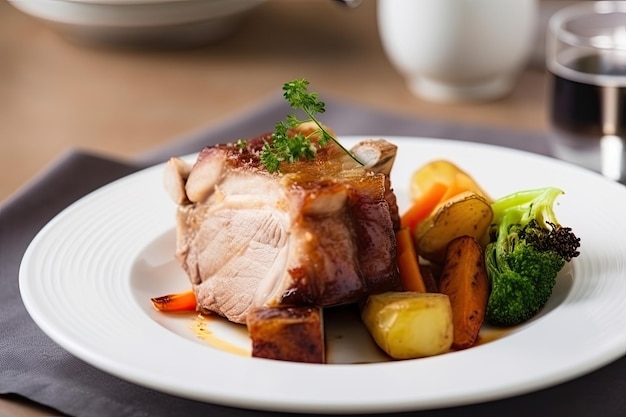As a seasoned cook, I've seen my fair share of pork loin disasters - dry, tough, and frankly, a bit of a letdown. But don't worry, my friend, I'm here to share the secrets I've learned over the years to guarantee a juicy, flavorful pork loin every single time. This isn't just a guide; it's a journey into the world of pork perfection, and I'm your trusted companion. So, grab your apron, sharpen your knives, and let's get cooking!
(Part 1) Choosing the Right Pork Loin: The Foundation of Success

Choosing the right pork loin is crucial for a successful dish. It's like picking the right ingredients for a delicious cake – if you start with a good base, the rest will fall into place.
Bone-In vs. Boneless: A Matter of Preference
Alright, now let's talk about the bone-in versus boneless debate. Personally, I'm a bone-in kind of guy. The bone adds a wonderful depth of flavor and helps to keep the meat moist during cooking. Plus, it's a great visual element on the platter! However, if you're looking for something a little easier to slice and serve, boneless is a great option. Just remember, a boneless loin will need a little more TLC to stay moist while cooking.
Size Matters: Planning for Your Guests
Don't underestimate the importance of size! A small loin, about 1-2 pounds, is perfect for a quick weeknight dinner, but if you're feeding a crowd, you'll need something bigger, like a 3-4 pound loin. Consider your guest list and the portion sizes you'll be serving.
The Tell-Tale Signs of a Great Pork Loin
Here's a quick checklist to help you choose the perfect pork loin:
- Color: A healthy pork loin should be a pale pink color, not too red or too gray. Avoid loins that are discolored or have an off-putting odor.
- Texture: The meat should feel firm and springy to the touch, not mushy or soft. A firm texture indicates freshness.
- Fat: Look for a loin that has a good amount of marbling, those little streaks of fat add richness and juiciness. Too much fat can be overwhelming, but too little can result in a dry loin.
Remember, a little extra time spent selecting your pork loin will pay off in the long run!
(Part 2) Prepping the Pork Loin: Setting the Stage for Flavor

Okay, you've got your perfect pork loin. Now it's time to get it ready for its starring role in your dinner. This part is all about setting the stage for flavor, and let me tell you, a little prep goes a long way.
The Importance of Patting Dry: Maximizing Crispness
This might seem obvious, but trust me, patting that pork loin dry is vital. Excess moisture will steam the meat during cooking, leading to a less crispy, less flavorful result. Take a few minutes to dry it off thoroughly with paper towels, ensuring every nook and cranny is dry.
Salt and Pepper: The Foundation of Seasoning
Now we're getting to the good stuff. Salt and pepper are the building blocks of any good pork loin recipe. I like to season liberally and evenly, getting those spices right into all the nooks and crannies. This will create a beautifully seasoned crust and enhance the natural pork flavor.
Beyond Salt and Pepper: Adding Depth and Complexity
If you're feeling adventurous, don't be afraid to play around with additional spices. Think of it as adding different instruments to your flavor orchestra. Some of my personal favorites include:
- Garlic powder: A classic that adds savory depth and aroma.
- Onion powder: A subtle but essential ingredient that adds warmth and sweetness.
- Paprika: A versatile spice that can add a touch of sweetness, smokiness, or heat depending on the type you choose.
- Dried herbs like thyme, rosemary, or oregano: These herbs bring a fresh, earthy, and aromatic dimension to your pork loin.
Experiment and find your own unique flavor combinations! Don't be afraid to create your own signature spice blend.
(Part 3) Cooking Methods: Choose Your Adventure

Here we go, the heart of the matter - cooking methods! Now, this is where I get really excited. There are so many amazing ways to cook a pork loin, each resulting in a delicious, juicy outcome. But don't worry, I'll guide you through the most popular and effective options.
1. Roasting in the Oven: The Classic Approach
Roasting is a classic method for a reason. It's simple, reliable, and results in a beautifully cooked pork loin every time. Preheat your oven to 375°F (190°C) and place the loin on a rack in a roasting pan. This allows for even heat circulation and prevents the loin from steaming in its own juices. Let it roast for about 15-20 minutes per pound, or until the internal temperature reaches 145°F (63°C).
2. Pan-Seared: Crispy on the Outside, Tender on the Inside
If you're looking for a crispy, flavorful pork loin, pan-searing is the way to go. Heat a heavy-bottomed pan over medium-high heat. A heavy pan helps to distribute heat evenly and prevent the pork from sticking. Add a little oil, just enough to coat the bottom of the pan, and sear the pork loin for 3-4 minutes per side. This creates a delicious crust. Transfer it to a preheated oven and continue cooking until the internal temperature reaches 145°F (63°C).
3. Slow-Cooking: Low and Slow for Maximum Flavor
For the ultimate melt-in-your-mouth pork loin, try slow-cooking! This method is perfect for busy weeknights, as you can just set it and forget it. Place the pork loin in a slow cooker, add your favorite seasonings and a little liquid, like broth or apple cider, and cook on low for 6-8 hours. The low and slow cooking process breaks down the tough fibers, resulting in incredibly tender, flavorful pork.
4. Grilled: Smokey Flavor and Outdoor Fun
If you're lucky enough to have a grill, don't hesitate to fire it up! A grilled pork loin is a delicious and festive option. Just make sure your grill is nice and hot, about 400°F (200°C). Cook the loin for 10-15 minutes per side, flipping it once or twice, and then reduce the heat to medium and continue cooking until the internal temperature reaches 145°F (63°C). The high heat sears the outside, creating a beautiful grill mark, while the lower heat cooks the loin through.
5. Air-Fryer: Quick and Easy, Crispy Results
The air fryer is a modern-day marvel, and it works wonders for pork loin! Preheat your air fryer to 400°F (200°C) and cook the loin for 15-20 minutes, flipping it halfway through. This method produces a crispy, flavorful pork loin in a fraction of the time, perfect for a quick weeknight meal.
(Part 4) Mastering the Internal Temperature: The Key to Perfection
Now, here's where it gets a little technical. You might be thinking, "How do I know when my pork loin is actually cooked through?" This is where a trusty meat thermometer comes in handy. It's your best friend in the kitchen, and it will help you achieve perfectly cooked pork loin, every single time.
Why Internal Temperature Matters: food safety First
Pork loin, like all meat, needs to reach a safe internal temperature to ensure it's cooked through and safe to eat. That magic number is 145°F (63°C). This temperature kills any harmful bacteria that may be present in the raw meat.
Using a Meat Thermometer: A Guide to Accuracy
Insert the meat thermometer into the thickest part of the pork loin, avoiding the bone. Make sure the thermometer is not touching the bone, as that could give you a false reading. Let the thermometer sit for a few seconds to get an accurate temperature reading.
Don't Overcook! The Art of Tenderness
It's important to note that pork loin is a lean cut of meat, so it can dry out quickly if overcooked. Once it reaches that magical 145°F (63°C), it's done! Don't overcook it; trust me, it's a mistake I've made in the past, and it's a lesson I'll never forget. overcooked pork loin can be tough and dry, so it's essential to stop cooking as soon as it reaches the desired temperature.
Resting is Key: Allowing the Juices to Redistribute
Once the pork loin is cooked, let it rest for 10-15 minutes before carving. This allows the juices to redistribute, resulting in a juicier and more flavorful pork loin. Cover the loin loosely with foil to keep it warm while it rests.
(Part 5) Flavor-Boosting Techniques: Taking Your Pork Loin to the Next Level
Okay, we're getting to the fun part. Now that you've got the basics down, let's talk about how to really amp up the flavor of your pork loin. These techniques are sure to impress your guests and make your pork loin truly unforgettable.
1. The Power of Brining: Hydration and Flavor Infusion
Brining is a secret weapon for juicy, flavorful pork loin. It involves soaking the loin in a salt-water solution for several hours, which helps to retain moisture and infuse it with flavor. The salt draws out moisture from the meat, then reabsorbs it along with the brine solution. This process makes the pork loin more tender and flavorful. I usually brine my pork loin for at least 4 hours, but you can do it overnight if you have the time.
2. The Magic of Marinades: A Flavor Bath
Marinades are like a flavor bath for your pork loin. They work by tenderizing the meat and adding a layer of deliciousness. The acids in the marinade break down the protein in the pork, making it more tender. Marinades can also add a variety of flavors, from sweet and tangy to savory and spicy. You can find countless marinade recipes online, or you can create your own with your favorite ingredients.
3. The Art of Glazing: Creating a Sweet and Savory Finish
A glaze can take your pork loin from ordinary to extraordinary. Just before cooking or in the last 30 minutes, brush the loin with a sweet and savory glaze, like a honey-soy glaze or a balsamic glaze. The glaze will caramelize in the oven or on the grill, creating a beautifully glossy finish and adding a burst of flavor.
4. The Versatility of Rubs: Spicing Things Up
dry rubs are a fantastic way to add depth and complexity to your pork loin. You can buy pre-made rubs, or you can make your own with a blend of spices and herbs. Apply the rub liberally to the pork loin, and let it sit for at least 30 minutes before cooking. The spices will penetrate the meat, adding flavor from the inside out.
(Part 6) Serving Suggestions: Pairings and Sides
Okay, your pork loin is cooked to perfection, and it's radiating deliciousness. Now let's talk about the best way to showcase this masterpiece. The right pairings and sides can take your meal from good to amazing.
Classic Sides for a Hearty Meal: Tried and True
- mashed potatoes: A classic comfort food that pairs beautifully with pork loin. The creamy texture of mashed potatoes complements the savory flavor of the pork.
- Roasted Vegetables: Add some color and flavor to your plate with roasted vegetables like carrots, Brussels sprouts, or asparagus. Roasted vegetables bring a touch of sweetness and earthiness to the meal.
- Green Salad: A refreshing and light counterpoint to the richness of the pork loin. A green salad helps to balance out the heavier flavors of the main course.
Creative Sides for a More Adventurous Meal: Stepping Out of the Box
- Apple-Cranberry Sauce: The sweet and tart flavors of this sauce complement the pork loin beautifully. The combination of apple and cranberry creates a tangy, festive flavor.
- Polenta: Creamy polenta is a luxurious and satisfying side for pork loin. Polenta provides a creamy contrast to the meat, and it's incredibly versatile, so you can experiment with different flavor combinations.
- sweet potato Fries: Crispy, sweet potato fries are a delicious and indulgent accompaniment. Sweet potato fries bring a touch of sweetness and a satisfying crunch to the meal.
Wine Pairings: The Perfect Complement
A good glass of wine can elevate your pork loin dinner to new heights. Here are a few suggestions:
- Dry white wines: Sauvignon Blanc or Pinot Grigio – these wines have crisp acidity that cuts through the richness of the pork loin.
- Rosé wines: A refreshing and versatile choice that pairs well with both the savory and sweet notes of pork loin.
- Light-bodied red wines: Pinot Noir or Zinfandel – these wines have a delicate fruitiness that complements the pork loin without overwhelming it.
(Part 7) Recipe Ideas: Inspiration for Your Next Pork Loin Feast
Now, let's get practical. I know you're itching to put all this knowledge to the test. Here are a few of my favorite pork loin recipes to get your culinary creativity flowing.
1. Honey Garlic Glazed Pork Loin
This recipe is a classic for a reason. The honey-garlic glaze is sweet, savory, and irresistible. The combination of honey and garlic creates a beautiful balance of sweet and savory flavors.
2. Rosemary and Garlic Pork Loin with Roasted Vegetables
This simple yet delicious recipe combines the flavors of rosemary, garlic, and roasted vegetables for a satisfying and aromatic meal. The rosemary and garlic add a wonderful depth of flavor to the pork, while the roasted vegetables provide a colorful and flavorful accompaniment.
3. slow cooker pork Loin with Apple Cider
Perfect for a busy weeknight, this slow cooker recipe produces tender, flavorful pork loin with a hint of apple cider sweetness. The apple cider adds a touch of sweetness and a warm, comforting aroma to the pork.
4. Grilled Pork Loin with Mango Salsa
Fire up the grill and enjoy a flavorful and refreshing pork loin with a sweet and tangy mango salsa. The mango salsa provides a bright and tropical counterpoint to the smoky flavor of the grilled pork.
(Part 8) FAQs: Addressing Your Burning Questions
Alright, you've absorbed a lot of information, and you might have some burning questions. Let's address a few of the most common queries.
1. Can I cook pork loin from frozen?
While technically possible, it's not ideal. Thawing the pork loin in the refrigerator overnight is the best way to ensure even cooking and prevent any potential food safety concerns. Frozen pork loin can be difficult to cook evenly, and it may not achieve the desired level of tenderness.
2. How long can I keep cooked pork loin in the fridge?
Cooked pork loin can be safely stored in the refrigerator for 3-4 days. Be sure to store it in an airtight container or wrap it tightly with plastic wrap. This will prevent the pork loin from drying out and absorbing other flavors in your fridge.
3. Can I freeze cooked pork loin?
Yes, you can freeze cooked pork loin for up to 2-3 months. It's best to freeze it in individual portions, making it easier to reheat later. This will help to prevent freezer burn and allow you to easily defrost only the amount you need.
4. What are the signs of a bad pork loin?
A bad pork loin will have a sour or unpleasant odor, and the meat may have a slimy texture. If you notice any of these signs, discard the pork loin. These are signs that the meat has spoiled and is no longer safe to eat.
5. What are some other ways to cook pork loin?
The possibilities are endless! You can also try braising, poaching, or even sous vide cooking. Experiment and discover your favorite method.
And there you have it! Your ultimate guide to cooking a juicy, flavorful pork loin. Now, go forth and create your culinary masterpiece. Remember, practice makes perfect, and don't be afraid to experiment. You've got this!
Everyone is watching

How to Cook Frozen Lobster Tails Perfectly: A Step-by-Step Guide
RecipesLobster. Just the word conjures up images of lavish meals, special occasions, and a taste of luxury. But let's...

Pork Fillet Cooking Time: How Long to Cook It Perfectly
RecipesPork fillet, or tenderloin as it's sometimes called, is a real favourite in our house. It's so versatile, and...

Pigs in a Blanket Cooking Time: How Long to Bake for Perfect Results
RecipesAh, pigs in a blanket. Just the name conjures up images of those delightful little parcels of crispy pastry en...

The Ultimate Guide to Cooking Delicious Frankfurters
RecipesLet's face it, we all love a good frankfurter. It's a classic, simple, and always satisfying. But let's be rea...

Wolf Meat Recipes: A Guide to Cooking Wild Game
RecipesLet's be honest, you don't see wolf meat at your local butcher shop every day. It's a bit of a wild card, but ...
